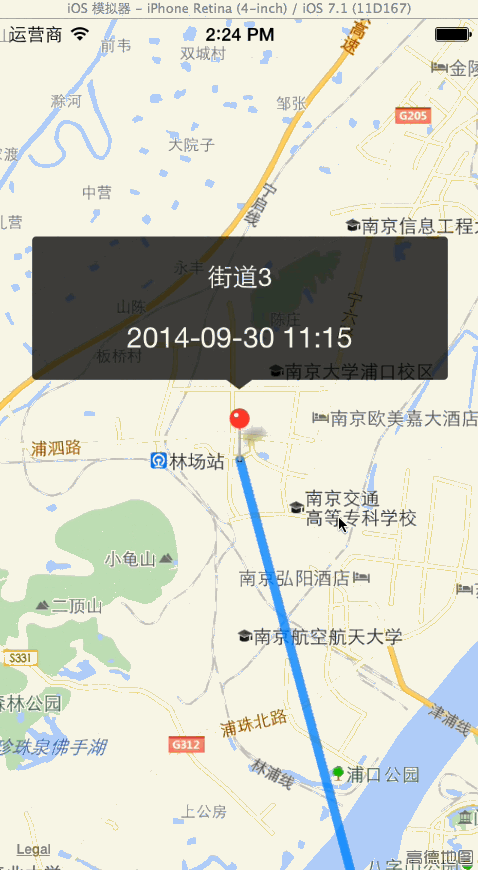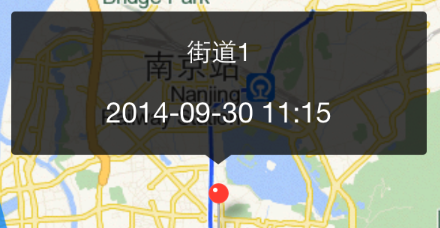请允许我模仿各路coding大神的习惯写法,使用“Working with MapKit”这样的装逼语句来说明本文要阐述的内容。没错,本文就是要将我之前学习使用MapKit Framework的过程、心得做一个总结。利用一个简单的栗子demo,来展现如何使用MapKit进行:1,标记若干个坐标,自定义MKAnnotation,显示附加信息;2,画出坐标点之间的线路图。
先来看一下效果:

demo我已经放在了这里:https://github.com/pigpigdaddy/MapDemo
使用MapKit进行地图标记和路径绘制,最重要的就是为需要标记的坐标设置正确的经纬度。项目开始时,我们需要加入MapKit.Framework,并在响应的文件内#import这个framework的接口文件。
1,MKMapView
1.1,MKMapView是一个继承自UIView的类,你可以直接使用initWithFrame来初始化这个地图视图,然后记得将它的实例的delegate属性设置好。MKMapView的实例有一个showsUserLocation属性,这个属性默认是NO,如果我将它设置为YES,那么地图上就会标注出我的设备的当前位置。
当我初始化好,设置好一切了后,就可以将它addSubView到我的视图上了。
1 self.mapView = [[MKMapView alloc] initWithFrame:CGRectMake(0, 0, self.frame.size.width, self.frame.size.height)]; 2 self.mapView.delegate = self; 3 self.mapView.showsUserLocation = YES; 4 [self addSubview:self.mapView];
就是这么简单。
1.2,地图交互
地图中的各类行为,比如定位当前位置、开始渲染地图、地图标记显示、地图标记选中、线路的绘画等等,都是由MKMapViewDelegate,给出的回调来定义的。根据我的demo,我将选取其中有关地图标记和线路绘画相关的几个回调,来实现他们,从而实现我在文章开始写出的两个功能。
主要用到的回调:
1 - (MKAnnotationView *)mapView:(MKMapView *)mapView viewForAnnotation:(id <MKAnnotation>)annotation;
1 - (void)mapView:(MKMapView *)mapView didSelectAnnotationView:(MKAnnotationView *)view NS_AVAILABLE(10_9, 4_0); 2 - (void)mapView:(MKMapView *)mapView didDeselectAnnotationView:(MKAnnotationView *)view NS_AVAILABLE(10_9, 4_0);
1 - (MKOverlayView *)mapView:(MKMapView *)mapView viewForOverlay:(id <MKOverlay>)overlay NS_DEPRECATED_IOS(4_0, 7_0);
2,地图标记<MKAnnotation>
2.1,MKAnnotation其实并不是一个类,而是一个协议。任何一个NSObject子类,如果想作为一个“地图标记”被加到地图(MKMapView)中,必须实现这个<MKAnnotation>协议。让我们来看看这个协议里面有些什么:
1 @protocol MKAnnotation <NSObject> 2 3 // Center latitude and longitude of the annotion view. 4 // The implementation of this property must be KVO compliant. 5 @property (nonatomic, readonly) CLLocationCoordinate2D coordinate; 6 7 @optional 8 9 // Title and subtitle for use by selection UI. 10 @property (nonatomic, readonly, copy) NSString *title; 11 @property (nonatomic, readonly, copy) NSString *subtitle; 12 13 // Called as a result of dragging an annotation view. 14 - (void)setCoordinate:(CLLocationCoordinate2D)newCoordinate NS_AVAILABLE(10_9, 4_0); 15 16 @end
说白了就是,你必须实现
1 @property (nonatomic, readonly) CLLocationCoordinate2D coordinate;
也就是地图标记的坐标!这样,你才能把该实例作为“Annotation”加到地图中去。
注意:1,你可以在同一个坐标点(经纬度)添加多个Annotation,这也是我的这个demo中用到的一个技巧;2,实现<MKAnnotation>的类,只是一个地图标记的“数据”,负责管理标记的“坐标”、“标题”等,而不管理标记“视图”,“视图”则由下面要介绍的MKAnnotationView来管理。
2.2,MKAnnotationView
MKAnnotationView是地图标记的“表现视图”,因为仅仅拥有<MKAnnotation>数据还不行,用户需要在地图中看到各式各样的“地图标记视图”。为此我创建了一个继承自MKAnnotationView的自定义视图用于弹出的界面:

这样,当用户点击地图上某个“标记Annotation”时,我会在此坐标处额外再次创建一个“Annotation”加到地图上,然后用我自定义的MKAnnotationView当做这个额外创建的“Annotation”的View。显示出来,就是上图中灰色半透明的界面。
所以你会发现,其实对于demo中的地图,任意一个时候是同时有四个Annotation的,分别是三个红色大头针的MKPinAnnotationView和一个当前选中的自定义MKAnnotationView。而当前选中的自定义MKAnnotationView和此大头针的MKPinAnnotationView其实是位于地图上同一个坐标的。
3,demo中的原始数据存储
我创建了一个叫LocationNode的节点类,用于存储原始数据。
1 // 主键 2 @property (nonatomic, assign) int index; 3 // 定位时间 4 @property (nonatomic, assign) int time; 5 // 位置经度 6 @property (nonatomic, assign) double lng; 7 // 位置纬度 8 @property (nonatomic, assign) double lat; 9 // 位置名称 10 @property (nonatomic, strong) NSString *street;
4,绘制路径
这在MapKit中其实是一个非常简单操作,只需要将每个坐标依次存于数组中,然后用此坐标数组初始化一个MKPolyline类的实例,最后用mapView的addOverlay方法,添加这个MKPolyline。然后在:
1 - (MKOverlayView *)mapView:(MKMapView *)mapView viewForOverlay:(id <MKOverlay>)overlay
回调中,配置绘制的路径的参数即可。
下面具体来看一下代码实现:
我创建了如下几个类:
PlaceMark:用于所有的Annotation,实现MKAnnotation协议;
CalloutMapAnnotation:用于当前选中时弹出的Annotation,在地图中,只保留一个实例,用于当前选中后额外创建的一个Annotation。
LocationNode:存储原始数据;
CallOutAnnotationView:继承自MKAnnotationView,用于上面所说的灰色半透明界面;
CustomCalloutView:一个自定义UIView,用于管理CallOutAnnotationView的实际内容;
LocationInfoMapView:地图创建在这个View中。
在LocationInfoMapView中,我们需要做下面的工作:
1 /** 2 TODO:显示地图标记 3 4 @param annotations 地图标记注释数组 5 6 @author pigpigdaddy 7 @since 3.0 8 */ 9 -(void)showAnnotation:(NSArray *)annotations{ 10 // 清除上一次地图标记 11 for (id annotation in self.mapView.annotations) { 12 if ([annotation isKindOfClass:[PlaceMark class]]) { 13 [self.mapView removeAnnotation:annotation]; 14 } 15 } 16 17 NSMutableArray *routes = [[NSMutableArray alloc] init]; 18 for (LocationNode *detailBean in annotations) { 19 // 添加每一个坐标到地图 20 PlaceMark *mark = [[PlaceMark alloc] initWithPlace:detailBean]; 21 [self.mapView addAnnotation:mark]; 22 23 // 创建一个数组,用于依次存储所有的坐标 24 CLLocation *location = [[CLLocation alloc] initWithLatitude:mark.coordinate.latitude longitude:mark.coordinate.longitude]; 25 [routes addObject:location]; 26 } 27 self.routes = routes; 28 29 // 将地图当前位置居中显示 30 [self centerMap]; 31 // 绘制路径 32 [self updateRouteView]; 33 }
1 /** 2 TODO:重新绘制导航视图 3 4 @author pigpigdaddy 5 @since 3.0 6 */ 7 - (void)updateRouteView{ 8 [self.mapView removeOverlays:self.mapView.overlays]; 9 10 CLLocationCoordinate2D pointsToUse[[self.routes count]]; 11 for (int i = 0; i < [self.routes count]; i++) { 12 CLLocationCoordinate2D coords; 13 CLLocation *loc = [self.routes objectAtIndex:i]; 14 coords.latitude = loc.coordinate.latitude; 15 coords.longitude = loc.coordinate.longitude; 16 pointsToUse[i] = coords; 17 } 18 MKPolyline *lineOne = [MKPolyline polylineWithCoordinates:pointsToUse count:[self.routes count]]; 19 [self.mapView addOverlay:lineOne]; 20 }
1 - (MKOverlayView *)mapView:(MKMapView *)mapView viewForOverlay:(id <MKOverlay>)overlay{ 2 if ([overlay isKindOfClass:[MKPolyline class]]){ 3 MKPolylineView *lineview = [[MKPolylineView alloc] initWithOverlay:overlay]; 4 // 路线颜色 5 lineview.strokeColor = [UIColor colorWithRed:0.0 green:126.0/255 blue:1.0 alpha:.75]; 6 // 宽度 7 lineview.lineWidth = 12.0; 8 return lineview; 9 } 10 return nil; 11 } 12 13 - (MKAnnotationView *) mapView:(MKMapView *)mapView viewForAnnotation:(id <MKAnnotation>) annotation { 14 if ([annotation isKindOfClass:[PlaceMark class]]) { 15 // 对于每一个坐标点,不论是否被选中,都用一个MKPinAnnotationView来显示标记 16 MKPinAnnotationView *annotationView = (MKPinAnnotationView *)[mapView dequeueReusableAnnotationViewWithIdentifier:@"PlaceMark"]; 17 if(annotationView == nil) { 18 annotationView = [[MKPinAnnotationView alloc] initWithAnnotation:annotation 19 reuseIdentifier:@"PlaceMark"]; 20 } 21 PlaceMark *mark = (PlaceMark *)annotation; 22 annotationView.pinColor = mark.pinColor; 23 annotationView.animatesDrop = NO; 24 annotationView.canShowCallout = NO; 25 return annotationView; 26 }else if ([annotation isKindOfClass:[CalloutMapAnnotation class]]){ 27 // 如果是当前选中的坐标点,那么会添加一个CalloutMapAnnotation,则此时用CallOutAnnotationView来显示标记 28 CallOutAnnotationView *annotationView = (CallOutAnnotationView *)[mapView dequeueReusableAnnotationViewWithIdentifier:@"CalloutView"]; 29 if (!annotationView) { 30 annotationView = [[CallOutAnnotationView alloc] initWithAnnotation:annotation reuseIdentifier:@"CalloutView"]; 31 CustomCalloutView *cell = [[[NSBundle mainBundle] loadNibNamed:@"CustomCalloutView" owner:self options:nil] objectAtIndex:0]; 32 [annotationView.contentView addSubview:cell]; 33 } 34 for (id subView in annotationView.contentView.subviews) { 35 if ([subView isKindOfClass:[CustomCalloutView class]]) { 36 CustomCalloutView *callout = (CustomCalloutView *)subView; 37 CalloutMapAnnotation *mapMark = (CalloutMapAnnotation *)annotation; 38 callout.addressLabel.text = mapMark.addr; 39 callout.addressTimeLabel.text = mapMark.time; 40 } 41 } 42 [annotationView showWithAnimation:YES]; 43 return annotationView; 44 } 45 return nil; 46 } 47 48 - (void)mapView:(MKMapView *)mapView didSelectAnnotationView:(MKAnnotationView *)view{ 49 if ([view.annotation isKindOfClass:[PlaceMark class]]) { 50 // 只响应大头针类型的 PlaceMark 标记的选中事件 51 PlaceMark *placeMark = (PlaceMark *)view.annotation; 52 self.calloutAnnotation = [[CalloutMapAnnotation alloc] 53 initWithLatitude:view.annotation.coordinate.latitude 54 andLongitude:view.annotation.coordinate.longitude]; 55 self.calloutAnnotation.addr = placeMark.locationDetailBean.street; 56 if (placeMark.locationDetailBean.time) { 57 NSDateFormatter *formatter = [[NSDateFormatter alloc] init]; 58 [formatter setDateFormat:@"yyyy-MM-dd HH:mm"]; 59 self.calloutAnnotation.time = [formatter stringFromDate:[NSDate dateWithTimeIntervalSince1970:placeMark.locationDetailBean.time]]; 60 } 61 62 // 创建并添加self.calloutAnnotation到地图 63 [mapView addAnnotation:self.calloutAnnotation]; 64 // 当前点居中 65 [mapView setCenterCoordinate:self.calloutAnnotation.coordinate animated:YES]; 66 67 // 点击回调,用于通知上层点击的事件 68 if (self.delegate && [self.delegate respondsToSelector:@selector(mapView:didShowCallOutViewWithDetailBean:)]) { 69 [self.delegate mapView:self didShowCallOutViewWithDetailBean:placeMark.locationDetailBean]; 70 } 71 } 72 } 73 74 - (void)mapView:(MKMapView *)mapView didDeselectAnnotationView:(MKAnnotationView *)view { 75 // 取消选中,删除这个Annotation标记 76 if (self.calloutAnnotation && ![view isKindOfClass:[CalloutMapAnnotation class]]) { 77 if (self.calloutAnnotation.coordinate.latitude == view.annotation.coordinate.latitude&& 78 self.calloutAnnotation.coordinate.longitude == view.annotation.coordinate.longitude) { 79 [mapView removeAnnotation:self.calloutAnnotation]; 80 } 81 } 82 }
别忘了在创建LocationInfoMapView的时候,先制作好原始数据,用于给LocationInfoMapView的showAnnotation:方法调用:
1 - (void)initData 2 { 3 self.locationArray = [[NSMutableArray alloc] init]; 4 LocationNode *node1 = [[LocationNode alloc] init]; 5 node1.index = 1; 6 node1.lng = 118.7862; 7 node1.lat = 32.05465; 8 node1.time = 1412046912; 9 node1.street = @"街道1"; 10 11 LocationNode *node2 = [[LocationNode alloc] init]; 12 node2.index = 2; 13 node2.lng = 118.7392; 14 node2.lat = 32.03229; 15 node2.time = 1412046912; 16 node2.street = @"街道2"; 17 18 LocationNode *node3 = [[LocationNode alloc] init]; 19 node3.index = 3; 20 node3.lng = 118.6984; 21 node3.lat = 32.16065; 22 node3.time = 1412046912; 23 node3.street = @"街道3"; 24 [self.locationArray addObject:node1]; 25 [self.locationArray addObject:node2]; 26 [self.locationArray addObject:node3]; 27 }
注释都写得很详尽,正如前面所说的,实现地图标记和路径绘制两个功能,非常关键的就是做好响应回调的实现。具体代码参考demo:
https://github.com/pigpigdaddy/MapDemo